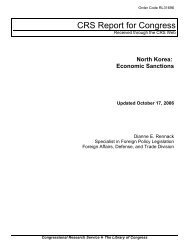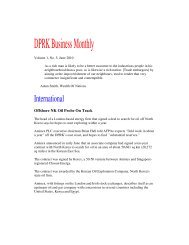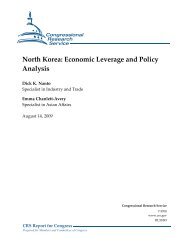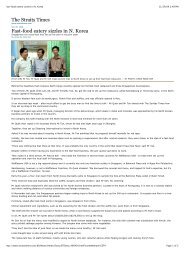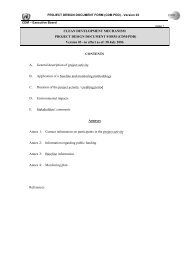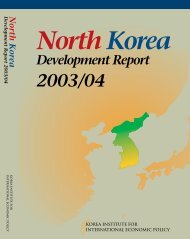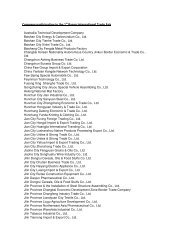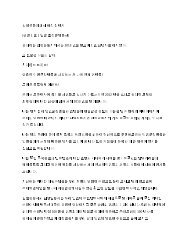North Korean Policy Elites - Defense Technical Information Center
North Korean Policy Elites - Defense Technical Information Center
North Korean Policy Elites - Defense Technical Information Center
You also want an ePaper? Increase the reach of your titles
YUMPU automatically turns print PDFs into web optimized ePapers that Google loves.
southward expansion, and, last but not least, the anti-U.S. struggle and the peaceful resolution of<br />
the nuclear crisis.<br />
D. WHO GOVERNS: THE HUB-AND-SPOKES MODEL OF DECISION-MAKING<br />
IN THE DPRK<br />
The <strong>North</strong> <strong>Korean</strong> government is neither a monolith nor a “black box.” It is a semiprivatized<br />
amorphous collection of rivaling immobile organizations and stove-piped<br />
bureaucracies that often act at cross purposes and are pressed hard and corrupted by the<br />
individual and group interests of competing clans, social and political forces vying for power,<br />
prestige, and wealth invested by the Dear Leader. <strong>North</strong> <strong>Korean</strong> policy-makers are rational and<br />
very predictable, whether one likes or dislikes their actions.<br />
The <strong>North</strong> <strong>Korean</strong> Byzantium upon the Taedong River<br />
Kim Jong Il is the absolute monarch presiding over the Byzantine Court on the Taedong<br />
River. His family clan resides in a modern-day Juch’e Constantinople, the Kim family-built<br />
DPRK capital of Pyongyang. The court encompasses at least six immediately related families<br />
(1+2+3), all competing for the emperor’s attention, devotion, and favors, and jockeying for<br />
position in the event of post-Kim Jong Il succession.<br />
Although it may be hard to believe, the race for the successor mantle and the inheritance<br />
of the “party center” has already begun among the third-generation “top echelon” of the<br />
revolution in <strong>North</strong> Korea. The year of 2004 has a threefold symbolic meaning in the <strong>North</strong><br />
<strong>Korean</strong> political history because it marks the 40th anniversary of Kim Jong Il’s beginning to<br />
work at the WPK Central Committee (at the Organizational Guidance Department and<br />
Propaganda and Agitation Department), the 30th anniversary of his designation as the heir<br />
apparent to his father Kim Il Sung, and the 10th anniversary of his assumption of power after the<br />
Great Leader’s death. As potential heirs to Kim Jong Il grow up and mature, they begin to<br />
develop their own bureaucratic attachments and personal loyalties. As their distinctive power<br />
bases consolidate and expand, their leadership ambitions tend to grow and legitimacy claims<br />
solidify. The battle orders of the future “estate fights” between the first-tier, second-tier, and<br />
third-tier families within the Kim clan are already shaping up, despite the urgent party calls for<br />
the elites to unite behind the “top echelon” of the revolution.<br />
As the power succession struggle intensifies, the political regime tends to crack along the<br />
lines of personal loyalties and “estate inheritance.” Some power-wielding organizations and<br />
interested outside parties may take a risk and choose to take sides up-front, expecting higher<br />
returns in the future; others may prefer to explore various alternatives as to who may come out<br />
IV-13



